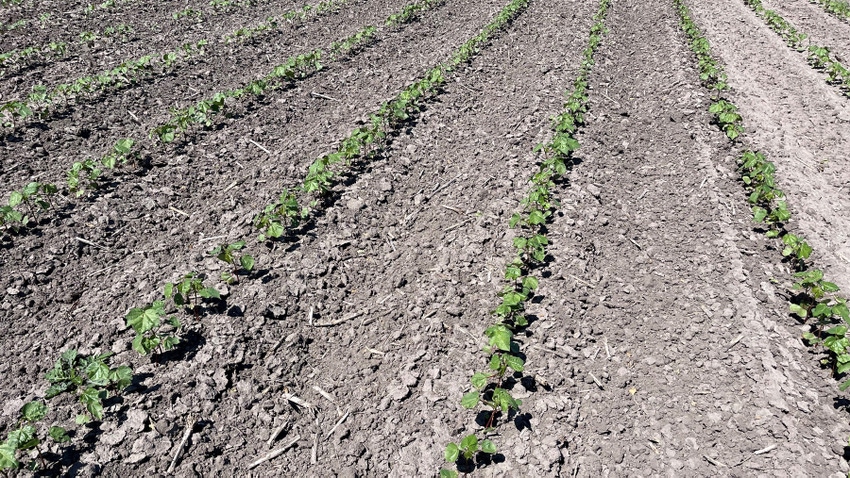
The Texas Boll Weevil Eradication program faces some significant challenges this season as growers and eradication personnel move closer to the end goal — no more boll weevils.
Edward Herrera, eradication program LRGV zone manager, encourages cotton producers to make sure no acreage is left without monitoring this season. “Boll weevil catches are historically low as we strive towards eradication,” Herera said in a recent Texas AgriLife IPM Pest Cast Newsletter.

Edward Herrera, Texas Boll Weevil Eradication Program LRGV zone manager (Photo by Shelley E. Huguley)
“Access around the entire perimeter of all cotton acreage is crucial to ensure good detection and that timely control methods are applied,” Herrera says. “Currently,12 weevil catches have been reported since January 1, 2024. All catches were reported in the far west area of the current year's cotton acreage.”
Herrera says the program faces significant challenges this year. “Consider this year’s acreage planted over 1,664 individual fields. Each of these fields must be visited weekly, and each trap location has to be visited and serviced.”
Challenges ahead
That’s not all.
“In addition to the current cotton acreage, the Foundation's personnel also monitor all carry-over acreage that was in cotton for the 2023 growing season. This is an additional 116,583.2 acres over the 2,285.4 individual fields serviced weekly. Within this acreage, 34,289 individual boll weevil traps are serviced weekly.
“It is crucial that producers monitor the fields planted in cotton for the 2024 growing season, and if traps are not deployed around the perimeter of cotton acreage, they should report to the local Boll Weevil office so that acreage can be monitored.”
Herrera says cotton crop stages range from just planted to squaring. “Some fields are receiving initial malathion treatments due to current weevil catches or historical data.”
Pest outlook
Danielle Sekula, AgriLife Extension IPM specialist and Pest Cast editor, says as of March 27 LRGV cotton farmers had planted about 105,237 acres. “We might have another 5,000 acres planted in the next few weeks,” she says.

Danielle Sekula, AgriLife Extension IPM specialist and Pest Cast editor (Photo by Shelley E. Huguley)
Sukula reports “lots of cotyledon cotton that just emerged. Most of the cotton I’ve scouted was in the 2 to 4 true leaf stages and we have a handful of cotton just starting to square across the LRGV.”
She says scouting so far has not detected significant pest issues. “All cotton looks clean of pests thus far in the early growth stages. The only pest I noticed this week was a couple of winged cotton aphids making their way into cotton fields.”
She says some severe sandblasted cotton in Cameron and Willacy counties east of HWY 77 “might need to be replanted. We also noticed possible herbicide uptake damage/effects to some cotton seedlings in some areas, but they should be able to grow out of it. Other than that, it was a very clean week in cotton.”
In an April 4 audio update, Sekula reported: “I’m not finding much on cotton, just seeing a few more cotton aphids moving into cotton, with lots of predators like ladybug larvae and adults already present and eating them.
“I did see a couple of fleahoppers in some cotton along the river, but all other cotton in the Valley still looks clean. I saw a lot more squaring cotton this week.
“I did see a couple of thrips, but all these pests were not at threshold, not worth spraying. I also picked up on a few spider mites, but I think it's because it's so dry and very dusty.”
Timely rains early
Sekula says growers have been planting since mid-February, starting with corn and grain sorghum then switching to cotton. She says the year started out “in severe drought and many water restrictions have been in place throughout the LRGV. Even though we have received some rainfall these last two months, restrictions continue.”
A timely rainfall February 16 through 18 provided much-needed moisture with most of the valley receiving 1 to 3 inches, depending on location.
“After it dried up, planting took off,” Sekula says. “Two weeks ago, we received another slew of slow rains, mainly drizzles that accumulated over 3 days, giving some areas anywhere from half-an-inch to 2 to 3 inches in isolated areas of the Valley.”
Other weather factors
She reports that heat unit accumulation this year is about 30% lower than this time last year. “Our daily temperatures have averaged around the mid-80s, with a couple of days in the last two weeks reaching 90. Nights have averaged about 60.”
She says high winds have been consistent, ranging from 20 to 30 mph daily. “If that continues, it will quickly dry up the soil moisture we have.”
A lot of sorghum
Sekula reports that a lot of grain sorghum is coming up, and sugarcane aphids are moving in.
“We have a lot of sorghum out there, and I have seen very high infestations of sugarcane aphids in the mid-valley in blooming sorghum. I want to remind everyone who has sorghum, whether it's a tolerant variety or a non-tolerant variety, once that sorghum starts into the booting stage and head exertion, you need to check it about twice a week to determine the level of sugarcane aphid infestations.
“For the most part, everybody knows what to use to control them, but it's imperative to start monitoring sorghum.”
Sekula says the heavy population was a surprise this early in April.
She adds that most of the sorghum all over the valley looks clean.
Corn
Sekula says she’s also seeing some aphids in corn whorls. “But it is good to have them come and start attracting ladybugs and other predators that will kind of take care of the little bit of sugarcane aphid activity.”

(Photo by Shelley E. Huguley)
Drought is a concern with corn and sorghum. “Corn and sorghum, but mainly the corn, looks stressed and is twisting its leaves to conserve moisture.
“We have a lot more sesame up this week, just germinating. I didn't see any pest concern on sesame.”
Audio update
Sekula says a weekly Audio Update for South Texas IPM is available this spring. “It’s a 5-minute update on what is going on in the LRGV and Coastal Bend areas,” she says. To sign up, click on this link: https://www.texasinsects.org/south-texas.html.
“You will receive a text when a new update is available and can listen to it in your truck, tractor, or wherever you may be. This does not replace the Pest Cast Newsletter but is an extra source of information.”
Read more about:
Boll WeevilAbout the Author(s)
You May Also Like






